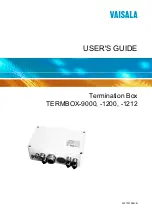
Chapter 8 Quality of Service (QoS)
Basic Home Station VDSL2 P8802T User’s Guide
135
Source MAC
Mask
Type the mask for the specified MAC address to determine which bits a packet’s MAC
address should match.
Enter “f” for each bit of the specified source MAC address that the traffic’s MAC address
should match. Enter “0” for the bit(s) of the matched traffic’s MAC address, which can be of
any hexadecimal character(s). For example, if you set the MAC address to
00:13:49:00:00:00 and the mask to ff:ff:ff:00:00:00, a packet with a MAC address of
00:13:49:12:34:56 matches this criteria.
Destination
MAC Address
Enter a MAC address to apply the classifier to packets destined for that MAC address.
Destination
MAC Mask
Type the mask for the specified MAC address to determine which bits a packet’s MAC
address should match.
Enter “f” for each bit of the specified source MAC address that the traffic’s MAC address
should match. Enter “0” for the bit(s) of the matched traffic’s MAC address, which can be of
any hexadecimal character(s). For example, if you set the MAC address to
00:13:49:00:00:00 and the mask to ff:ff:ff:00:00:00, a packet with a MAC address of
00:13:49:12:34:56 matches this criteria.
Source IP
Address[/Mask]
Select this and enter an IP address to apply the classifier to packets from that IP address.
You can also include a source subnet mask.
Vendor Class ID
(DHCP Option
60)
Select this and enter the Vendor Class Identifier (Option 60) of the matched traffic, such as
the type of the hardware or firmware.
User Class ID
DHCP option 77
Select this and enter a string that identifies the user’s category or application type in the
matched DHCP packets.
Destination IP
Address[/Mask]
Enter an IP address to apply the classifier to packets destined for that IP address. You can
also include a destination subnet mask.
Differentiated
Service Code
Point (DSCP)
Check
Select a DSCP mark of traffic to which to apply the classifier.
802.1p Priority
Check
This field is available only when you set the Ether Type field to 8021Q.
Select the IEEE 802.1p priority level (between 0 and 7) of traffic to which to apply the
classifier. "0" is the lowest priority level and "7" is the highest.
Specify
Classification
Results
Configure these fields to change traffic that matches the classifier. The fields available vary
depending on the selected interface, Ether type, and sometimes on the selected class
queue. Leave a field blank to not apply that type of change.
Specify Class
Queue
Select the queue to which to add traffic that matches this classifier.
Forward To
Interface
Select a WAN interface through which to forward traffic of this class. Select Unchange to
forward traffic of this class according to the default routing table.
Mark
Differentiated
Service Code
Point (DSCP):
Select the DSCP mark to add to traffic that matches this classifier. Use Auto marking to
automatically apply a DSCP mark according to the type of traffic. Use default to leave the
DSCP mark unchanged.
Protocol
Select a service type (TCP, UDP, ICMP or IGMP) of traffic to which to apply the classifier.
Mark 802.1p
priority
Select the IEEE 802.1p priority level to assign to traffic that matches this classifier.
Set Rate Limit
Set the rate limit to apply to traffic that matches this classifier.
Apply/Save
Click this button to save your changes.
Table 43
QoS Classification Setup: Add (continued)
LABEL
DESCRIPTION
Summary of Contents for P8802T
Page 10: ...Table of Contents Basic Home Station VDSL2 P8802T User s Guide 10...
Page 11: ...11 PART I User s Guide...
Page 12: ...12...
Page 58: ...Chapter 2 User Setup Guide Basic Home Station VDSL2 P8802T User s Guide 58...
Page 59: ...59 PART II Technical Reference...
Page 60: ...60...
Page 74: ...Chapter 3 Device Info Screens Basic Home Station VDSL2 P8802T User s Guide 74...
Page 120: ...Chapter 6 Network Address Translation NAT Basic Home Station VDSL2 P8802T User s Guide 120...
Page 150: ...Chapter 10 DNS Setup Basic Home Station VDSL2 P8802T User s Guide 150...
Page 160: ...Chapter 11 UPnP Basic Home Station VDSL2 P8802T User s Guide 160...
Page 168: ...Chapter 12 USB Services Basic Home Station VDSL2 P8802T User s Guide 168...
Page 200: ...Chapter 14 Wireless Basic Home Station VDSL2 P8802T User s Guide 200...
Page 204: ...Chapter 15 Voice Basic Home Station VDSL2 P8802T User s Guide 204...
Page 240: ...Chapter 16 Diagnostic Basic Home Station VDSL2 P8802T User s Guide 240...
Page 244: ...Chapter 17 Settings Basic Home Station VDSL2 P8802T User s Guide 244...
Page 248: ...Chapter 18 Log Basic Home Station VDSL2 P8802T User s Guide 248...
Page 252: ...Chapter 19 TR 069 Client Basic Home Station VDSL2 P8802T User s Guide 252...
Page 254: ...Chapter 20 Internet Time Basic Home Station VDSL2 P8802T User s Guide 254...
Page 256: ...Chapter 21 Access Control Basic Home Station VDSL2 P8802T User s Guide 256...
Page 260: ...Chapter 23 Reboot Basic Home Station VDSL2 P8802T User s Guide 260...
Page 268: ...Chapter 24 Troubleshooting Basic Home Station VDSL2 P8802T User s Guide 268...
Page 272: ...Appendix A Legal Information Basic Home Station VDSL2 P8802T User s Guide 272...
















































